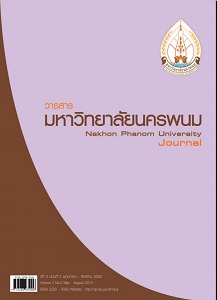ยุทธศาสตร์การพัฒนาศักยภาพที่เอื้อต่อการปฏิบัติงานของบุคลากร แขนงคุ้มครองทางน้ำ แผนกโยธาธิการและขนส่ง เมืองไกสอนพรมวิหานแขวงสะหวันนะเขต สาธารณรัฐประชาธิปไตยประชาชนลาว
Main Article Content
Abstract
การวิจัยมีวัตถุประสงค์เพื่อ 1) ศึกษาสภาพปัจจุบัน ปัญหาและความต้องการพัฒนาตนเอง 2) สร้างยุทธศาสตร์การพัฒนาและ 3) ทดสอบผลการใช้ยุทธศาสตร์การพัฒนา กลุ่มตัวอย่าง ประกอบด้วย บุคลากรแขนงคุ้มครองทางน้ำ โดยเลือกแบบเจาะจง จำนวน 10 คน เครื่องมือที่ใช้ในการวิจัย ประกอบด้วย แบบสัมภาษณ์แบบไม่มีโครงสร้าง และแบบสอบถามมาตราส่วนประมาณค่า 5 ระดับ มีค่าความเชื่อมั่นเท่ากับ 0.89 สถิติที่ใช้ในการวิเคราะห์ข้อมูล คือ ค่าร้อยละ ค่าเฉลี่ย และค่าส่วนเบี่ยงเบนมาตรฐาน เครื่องมือที่ใช้ใน การวิจัย ได้แก่ แบบประเมินศักยภาพที่เอื้อต่อการปฏิบัติงานแบบ วัดตนเอง และแบบประเมินความพึงพอใจในการเข้าร่วมกิจกรรม การวิเคราะห์ข้อมูล ใช้การวิเคราะห์เชิงปริมาณ สถิติที่ใช้ ได้แก่ ค่าเฉลี่ย และค่าเบี่ยงเบนมาตรฐาน ผลการวิจัยพบว่า 1) สภาพปัจจุบัน เกี่ยวกับศักยภาพที่เอื้อต่อการปฏิบัติงาน ในภาพรวมทั้ง 3 ด้าน บุคลากรประเมินตนเองว่าอยู่ในระดับปานกลาง ( = 3.31, S.D. = 0.55) เมื่อพิจารณารายด้านเรียงลำดับจากน้อยไปมาก ได้แก่ ศักยภาพด้านการจัดระบบและการวางแผนงาน (
= 3.15, S.D. = 0.55) ด้านทักษะ และคุณลักษณะเฉพาะของบุคคล (
= 3.26, S.D.= 0.61) ด้านการอำนวยความสะดวกและรวดเร็วในการให้บริการ (
= 3.52, S.D. = 0.61) ตามลำดับ 2) สร้างยุทธศาสตร์การพัฒนาศักยภาพที่เอื้อต่อการปฏิบัติงานที่สอดคล้องกับปัญหาที่ต้องการ พัฒนา มี 3 กิจกรรม ได้แก่ 2.1) ฝึกอบรมเพื่อเสริมสร้างความรู้ความเข้าใจเกี่ยวกับการบริหารแผนงานและโครงการ 2.2) ฝึกอบรมเพื่อ ทบทวนทำความเข้าใจวางระบบโครงสร้างงานในองค์กรบทบาทหน้าที่ และวิธีการปฏิบัติงานอย่างชัดเจน และ 2.3) ฝึกอบรมเพื่อเสริม สร้างความรู้ ทักษะ และการประยุกต์ใช้โปรแกรมคอมพิวเตอร์และ 3) ผลการทดลองใช้ยุทธศาสตร์การพัฒนาศักยภาพที่เอื้อต่อ การปฏิบัติงาน พบว่า บุคลากรมีความรู้ ความเข้าใจในเนื้อหาสาระต่างๆ หลังการเข้าร่วมกิจกรรมสูงกว่าก่อนการเข้าร่วมในระดับมาก (
= 4.70, S.D. = 0.28) และมีความพึงพอใจต่อการเข้าร่วมกิจกรรมในระดับมาก (
= 4.54, S.D. = 0.44)
The objectives of this study were: 1) to investigate a present state, problem and need of self-development, 2) to create a strategy for development, and 3) to test the result of implementing the development strategy. A sample consisted of10 personnel of Section of Waterway Management selected by purposive sampling. The instruments used in this study comprised an unstructured interview and a 5-rating scale questionnaire whose entire reliability value was 0.89. Statistics used to analyze data were percentage, mean, and standard deviation. The instruments used were a form for assessment of ability conducive to job performance, a self-measurement form, and a questionnaire for assessment of satisfaction of activity involvement. Data analysis was conducted using qualitative analysis. Statistics used were mean and standard deviation. The findings revealed as follows: 1)The present state of ability conducive to job performance in the 3 aspects as a whole as assessed by the personnel themselves was at the medium level ( = 3.31, S.D. = 0.55). Considering it by aspect from lower to higher rankings, they were those aspects of ability in system management and planning (
= 3.15, S.D. = 0.55), in skill and specific quality of the personnel (
= 3.26, S.D. = 0.61), and in giving facilities and quickness in service (
= 3.52, S.D. = 0.61) respectively. 2) Creating a strategy for developing ability conducive to job performance was consistent with the problem needed to be solved and developed comprising 3 activities. They were: 2.1) giving a training for enhancing knowledge and understanding about management of a plan and project; 2.2) giving a training for reviewing: how to lay down the system of organizational structure, the role, and how to perform the job in order to come to a clear understanding; 2.3) giving a training for enhancing knowledge skill, and application of computer program. And 3) The result of implementation of the strategy for developing ability conducive to job performance showed that the personnel had higher knowledge and understanding about different contents after their activity involvement than that before involvement which was at the high degree (
= 4.70, S.D. = 0.28) and their satisfaction of activity involvement was at the high level too (
= 4.54, S.D. = 0.44).


